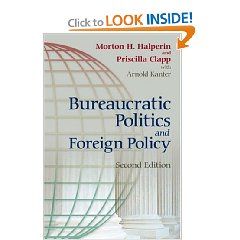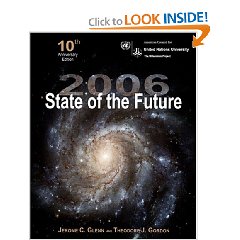Michael R. Gordon
EDIT of 11 Dec 07: my original comments have been validated. Adding links now that this feature is available, and a few additional references.
The index in this book is *terrible*, my first clue, as the #1 Amazon reviewer of non-fiction about national security, that something is amiss. There is no bibliography. That's my second clue. The footnotes are solid on interviews and Op-Eds, and abyssmal on books by other people–we'll give them a bye on that one, considering this a primary reference that is a partial picture.
The one theme that comes across, and it is partly motivated by a proper sense of restoring honor and reputation for the Army, is the constant degree to which Army officers gave the civilians good advice, only to see it ignored. The Army Chief of Staff got it right on post-conflict nation-building and needed manpower; the Army flags got it right in telling Bremer that that single dumbest thing he could do was disband the Army and put 100,000 pissed off Iraqis with guns on the street–but by golly, Bremer went ahead and did it.
Overall I do not find this book worthy of four stars (not even close for five) for the following reasons:
1) It is largely a white-wash, granted with lots of excellent detail, but it tells the story from the CINC and DCINC points of view, and I have previously reviewed those books and found them lacking in complete candor and full detail.
2) The book completely ignores all the negatives that have long-since been documented–the fact that Charlie Allen at CIA did send in 35 line-crossers and proved conclusively there were no Weapons of Mass Destruction; the fact that Chalabi was a thief and a liar fired by CIA and then used by Iran as an agent of influence to lick the ears of the neo-cons and persuade Rumsfeld (with help from the Mossad, which knew a coincidence of interest with the Iranians when they saw one) that it would be roses in the streets and a cheap war. The book completely ignores the peak oil imperatives that drove Cheney and the ugly post war realities including Paul Bremer “losing” $20 billion in loose cash, and Afghanistan becoming the source of 80% of the world's heroin (turned into #4 quality by our ally Pakistan).
2) The book ignores technical details that are my litmus test for full veracity. The fact that the White House and the military refused to put a Ranger battalion in to block Bin Laden's ground escape, tracked by CIA for four days (see my review of Jawbreaker: The Attack on Bin Laden and Al-Qaeda: A Personal Account by the CIA's Key Field Commander), the fact that Rumsfeld very stupidly gave the Pakistani's an air corridor to evacuate their officers and they instead evacuated 3,000 Taliban and Al Qaeda from Tora Bora in one night)….the list goes on.
The book gets the high points right (misreading of the foe, dysfunction of US military bureaucracy, over reliance by Rumsfeld on technology, the failure to recognize reality once in (insurgents instead of parades), and the Bush disdain for nation-building) BUT the authors also soft-shoe all the other issues, of which I see three:
1) The Administration lied to Congress, the American People, and the United Nations. A memo is now out in Lawless World that shows clearly that Bush and Blair agreed to go to war and all that followed was posturing–certainly an impeachable offense if ever there was one. See Weapons of Mass Deception: The Uses of Propaganda in Bush's War on Iraq.
2) Tommy Franks did not give a rat's ass what the Joint Chiefs thought, and Franks was chosen to do exactly that, while the Chairman of the Joint Chiefs was chosen because he would accept the role of floor mat rather than doing what any self-respecting officer should do, which is resign and be noisy in public.
3) The book fails to do as good a job as The Price of Loyalty: George W. Bush, the White House, and the Education of Paul O'Neill or State of War: The Secret History of the CIA and the Bush Administration in showing just how mendacious and dysfunctional was the Cheney-Rumsfeld coup d'etat within the White House. David Ropkoph's Ruling the World, several other books, make it quite clear that Condi Rice and Colin Powell were rolled, George Tenet was a raving sycophant, and our military was too eager to please, while Congress was pathologically absent without leave (AWOL).
The authors really would have done a vastly superior job had they actually read and integrated the varied books, e.g. Squandered Victory: The American Occupation and the Bungled Effort to Bring Democracy to Iraq, the various books readily available on the web of lies that led to war, on the incompetence of George Tenet, etc.
In all of this we do not see an adequate assessment of the role of Iran in carrying out what may be the greatest strategic deception of modern history, nor do we see any evaluation of the political-legal, socio-economic, ideo-cultural, or techno-demographic cost to America. This book closes as if the war is virtually over, the Army is reconstituted rather than hollow, and its time to discuss the lessons learned over a double scotch. Not so fast, bubbas.
In 2007 we have, apart from multiple books detailed how and why Bush and Cheney should be impeached, an entire literature on their alledged high crimes and misdemeanors on 9-11, and the follow gems:
Vice: Dick Cheney and the Hijacking of the American Presidency
The One Percent Doctrine: Deep Inside America's Pursuit of Its Enemies Since 9/11
A Pretext for War: 9/11, Iraq, and the Abuse of America's Intelligence Agencies
Running on Empty: How the Democratic and Republican Parties Are Bankrupting Our Future and What Americans Can Do About It
The Broken Branch: How Congress Is Failing America and How to Get It Back on Track (Institutions of American Democracy)
Breach of Trust: How Washington Turns Outsiders Into Insiders
This is not all on Cheney and the neo-cons. Any Congress stupid enough, limp enough, to allow Paul Wolfowitz to contradict the Chief of Staff of the U.S. Army on a topic about which Wolfowitz remains copmpletely ignorant, is not a Congress fulfilling its Article 1 responsibilities. The whole lot of them should be dismissed in 2008, and we should start over with Independents in charge and leadership psotions in both the Congress and the Cabinet aportioned across at least five distinct parties.









